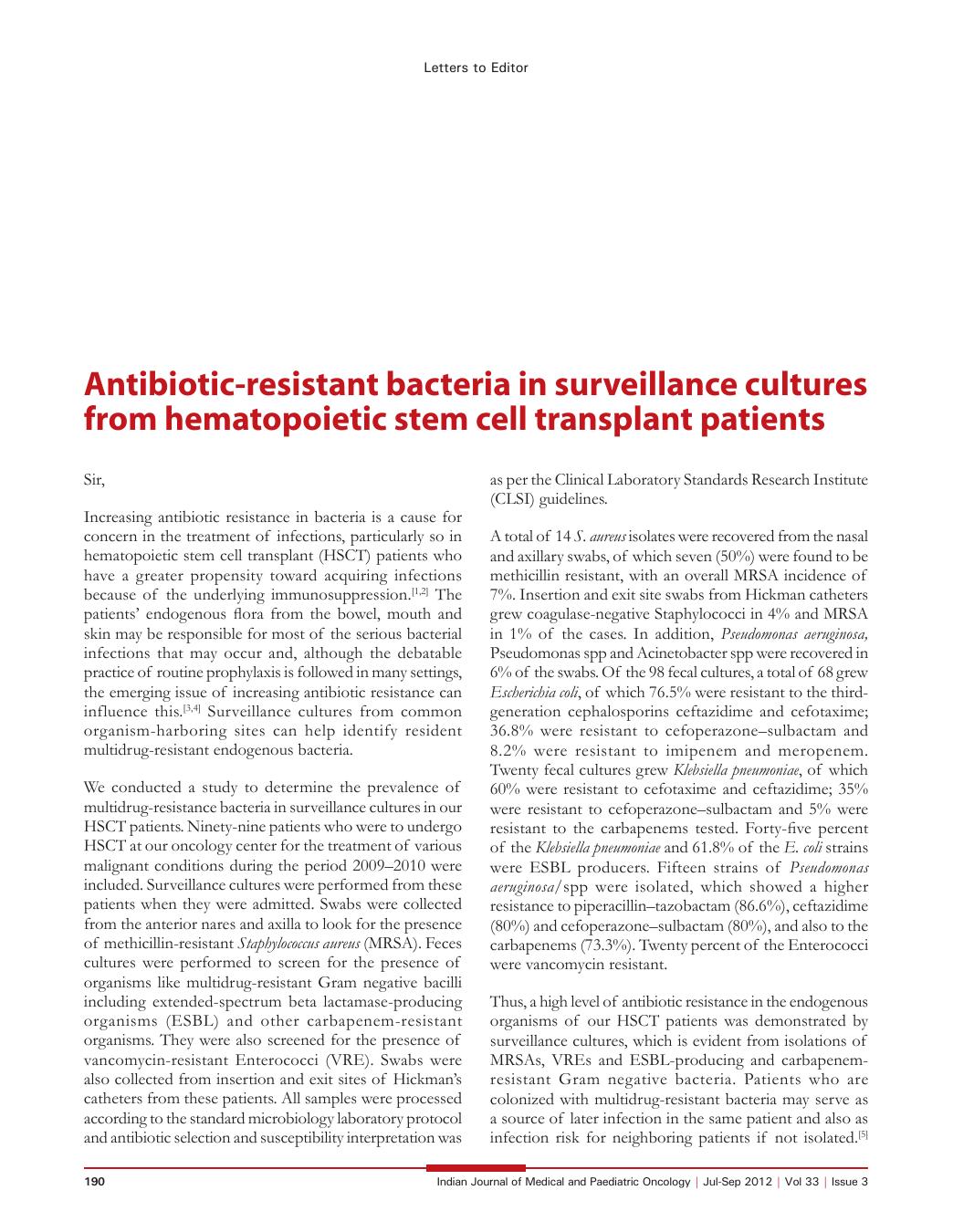Antibiotic-resistant bacteria in surveillance cultures from hematopoietic stem cell transplant patients
CC BY-NC-ND 4.0 · Indian J Med Paediatr Oncol 2012; 33(03): 190-191
DOI: DOI: 10.4103/0971-5851.103156

Publication History
Article published online:
02 August 2021
© 2012. Indian Society of Medical and Paediatric Oncology. This is an open access article published by Thieme under the terms of the Creative Commons Attribution-NonDerivative-NonCommercial-License, permitting copying and reproduction so long as the original work is given appropriate credit. Contents may not be used for commercial purposes, or adapted, remixed, transformed or built upon. (https://creativecommons.org/licenses/by-nc-nd/4.0/.)
Thieme Medical and Scientific Publishers Pvt. Ltd.
A-12, 2nd Floor, Sector 2, Noida-201301 UP, India
Sir,
Increasing antibiotic resistance in bacteria is a cause for concern in the treatment of infections, particularly so in hematopoietic stem cell transplant (HSCT) patients who have a greater propensity toward acquiring infections because of the underlying immunosuppression.[1,2] The patients’ endogenous flora from the bowel, mouth and skin may be responsible for most of the serious bacterial infections that may occur and, although the debatable practice of routine prophylaxis is followed in many settings, the emerging issue of increasing antibiotic resistance can influence this.[3,4] Surveillance cultures from common organism-harboring sites can help identify resident multidrug-resistant endogenous bacteria.
We conducted a study to determine the prevalence of multidrug-resistance bacteria in surveillance cultures in our HSCT patients. Ninety-nine patients who were to undergo HSCT at our oncology center for the treatment of various malignant conditions during the period 2009–2010 were included. Surveillance cultures were performed from these patients when they were admitted. Swabs were collected from the anterior nares and axilla to look for the presence of methicillin-resistant Staphylococcus aureus (MRSA). Feces cultures were performed to screen for the presence of organisms like multidrug-resistant Gram negative bacilli including extended-spectrum beta lactamase-producing organisms (ESBL) and other carbapenem-resistant organisms. They were also screened for the presence of vancomycin-resistant Enterococci (VRE). Swabs were also collected from insertion and exit sites of Hickman's catheters from these patients. All samples were processed according to the standard microbiology laboratory protocol and antibiotic selection and susceptibility interpretation was as per the Clinical Laboratory Standards Research Institute (CLSI) guidelines.
A total of 14 S. aureus isolates were recovered from the nasal and axillary swabs, of which seven (50%) were found to be methicillin resistant, with an overall MRSA incidence of 7%. Insertion and exit site swabs from Hickman catheters grew coagulase-negative Staphylococci in 4% and MRSA in 1% of the cases. In addition, Pseudomonas aeruginosa, Pseudomonas spp and Acinetobacter spp were recovered in 6% of the swabs. Of the 98 fecal cultures, a total of 68 grew Escherichia coli, of which 76.5% were resistant to the third-generation cephalosporins ceftazidime and cefotaxime; 36.8% were resistant to cefoperazone–sulbactam and 8.2% were resistant to imipenem and meropenem. Twenty fecal cultures grew Klebsiella pneumoniae, of which 60% were resistant to cefotaxime and ceftazidime; 35% were resistant to cefoperazone–sulbactam and 5% were resistant to the carbapenems tested. Forty-five percent of the Klebsiella pneumoniae and 61.8% of the E. coli strains were ESBL producers. Fifteen strains of Pseudomonas aeruginosa/spp were isolated, which showed a higher resistance to piperacillin–tazobactam (86.6%), ceftazidime (80%) and cefoperazone–sulbactam (80%), and also to the carbapenems (73.3%). Twenty percent of the Enterococci were vancomycin resistant.
Thus, a high level of antibiotic resistance in the endogenous organisms of our HSCT patients was demonstrated by surveillance cultures, which is evident from isolations of MRSAs, VREs and ESBL-producing and carbapenem-resistant Gram negative bacteria. Patients who are colonized with multidrug-resistant bacteria may serve as a source of later infection in the same patient and also as infection risk for neighboring patients if not isolated.[5] Surveillance cultures may be helpful in identifying these multidrug-resistant bacteria, which may have a bearing on further patient management.


 PDF
PDF  Views
Views  Share
Share

